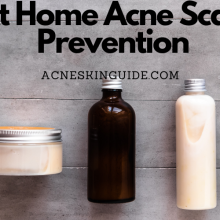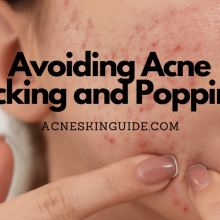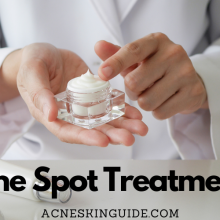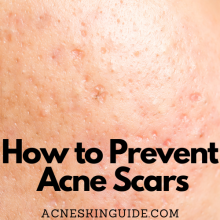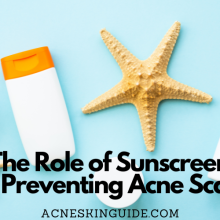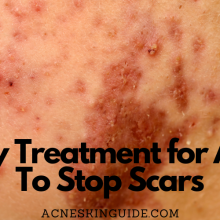Acne Patch Treatments – Using Hydrocolloid Bandages to Prevent Scars | AcneSkinGuide
Summary of Acne Patch Treatments
Hydrocolloid bandages are emerging as a game-changing solution for preventing acne scars. These specialized dressings absorb fluid and maintain a moist environment, allowing pimples to heal properly without drying out or scabbing over improperly. Their multi-layered construct includes an outer protective layer and an inner hydrocolloid layer that gels wound fluid. When used overnight on whiteheads or freshly drained pimples, the bandages minimize inflammation, protect the area, and reduce the risk of atrophic scarring.
Key benefits include faster healing, fluid absorption, stopping pimple picking, and convenient targeted treatment. While not recommended for cystic acne, hydrocolloid bandages offer an effective, affordable home treatment for getting blemishes under control with reduced risk of stubborn dark marks or pitted scars remaining. Their impressive results are generating buzz among skincare enthusiasts as a holy grail for clear, smooth skin.

Dealing with Acne Scars? Try Hydrocolloid Bandage Patches
For those plagued by acne, the formation of scars and dark marks can feel like adding insult to injury. Just when you think you’ve finally gotten a pimple under control, it leaves behind a stubborn reminder in the form of pitting, discoloration, or an elevated mark. Traditional acne treatments focus on clearing up active breakouts, but don’t always prevent the scarring that can linger long after.
Hydrocolloid bandages have emerged as an innovative game-changer for protecting skin and preventing acne scars. These specialized dressings create the ideal healing environment by absorbing fluid and maintaining moisture levels. When used as targeted acne patch treatments, they allow pimples to heal properly with minimized risk of scarring.
What Are Hydrocolloid Bandages?
On the surface, hydrocolloid bandages appear similar to regular adhesive bandages. But their multi-layered construct is specifically engineered for optimal wound care. The outer layer is impermeable, forming a protective seal to keep out bacteria while trapping fluid from the wound site.
The inner layer contains hydrocolloids – moisture-absorbing particles that turn fluid into a gel-like substance. This prevents scabbing and drying out of the wound. Instead, it creates a moist environment that promotes faster healing by enabling new skin cells to regenerate easily.
While originally designed for injuries and surgical incisions, hydrocolloid technology has found an incredibly effective use as an acne treatment. The bandages absorb the fluid from pimples and whiteheads, while shielding the area from further irritation or disruption during the healing process.
Using Hydrocolloid Bandages on Acne
To use hydrocolloid bandages for acne treatment, first thoroughly cleanse the face and let it fully dry. Then, apply the bandage directly over the pimple, smoothing it down to create a seal. Hydrocolloid patches sized specifically for the face can make this easier.
Hydrocolloid bandages work best when used overnight on whiteheads or after lancing a pimple, when fluid can still drain out gradually. However, they should not be used on deep, undersurface cystic acne, as they cannot absorb that type of fluid effectively.
With proper overnight use, you should see a noticeable difference in the blemish within just 1-2 days. Gone will be the whitehead or pus, absorbed into the bandage’s gel layer. The redness and swelling should also be significantly reduced, as the moist environment helps calm inflammation. Full healing of the spot may still take up to a week.
The Key Benefits
So what makes hydrocolloid bandages such an optimal solution compared to just leaving pimples alone? Their benefits for acne treatment are multi-faceted:
- Faster Healing: The moist, sealed environment enables the skin to regenerate and heal pimples faster than leaving them open.
- Prevent Scarring: By stopping the wound from drying out and scabbing over improperly, hydrocolloid dressings reduce the risk of developing atrophic acne scars or marks.
- Absorb Fluids: The gel layer absorbs and traps pus, oil, and fluids drained from the pimple, preventing further skin irritation.
- Protect the Area: The bandage forms a protective cover, stopping you from unconsciously picking at the blemish which can lead to scarring.
- Convenience: As a spot treatment, the bandages only need to be applied to individual pimples rather than covering the whole face with creams or medications.
Getting the Best Results
To maximize the efficacy of hydrocolloid acne patches, be diligent about changing them daily or whenever they’ve become saturated. Always apply the bandages to a clean, dry face as well.
While effective on their own, hydrocolloid bandages can also be combined with other acne treatments. Using a salicylic acid treatment on the surrounding area can help further clear up acne and prevent future breakouts. The bandage will still protect the spot as it heals.
When removing, be sure to peel off the hydrocolloid patch gently and slowly. Yanking it could damage the new skin that has formed underneath.
Addressing Potential Downsides
For the most part, hydrocolloid bandages are safe, affordable, and very low-risk as an acne treatment. However, there are a few potential downsides to be aware of:
- Not Recommended for Cystic Acne: As mentioned, deep cystic acne cannot be treated effectively with hydrocolloid bandages alone. The fluid cannot be properly absorbed.
- May Not Prevent All Scarring: While significantly reducing acne scar formation, hydrocolloid treatments cannot eliminate the risk entirely in some cases.
- Difficulty Wearing With Makeup: The bandages make it challenging to apply makeup over the treated area during the day.
- Edges Can Dry Out Skin: If not applied smoothly, the bandage edges may dry out skin around the acne spot. Prepping the area with moisturizer can help.
Overall, the benefits of hydrocolloid bandages for rapid acne healing and scar prevention far outweigh the minimal downsides. With their ease of use and efficacy, they are an accessible solution for getting blemishes under control.
Real Results from Hydrocolloid Enthusiasts
The buzz around using hydrocolloid bandages as acne patches has been steadily growing among beauty influencers, skincare enthusiasts, and communities like r/SkincareAddiction. Before and after photos shared on social media demonstrate their impressive results.
Many avid users tout hydrocolloid bandages as the long-awaited answer for preventing their stubborn acne scarring. The protective treatment helps fresh blemishes heal cleanly while fading old scars and marks. After consistent use, improved overall skin clarity and smoothness is visible.
As an easy, affordable home treatment, hydrocolloid bandages are becoming a holy grail product for clear, scar-free skin. Their innovative gel technology creates the ideal environment for pimples to heal properly from the outset. Say goodbye to painstakingly covering dark marks after the fact – these patches allow you to get ahead of potential acne scarring.
FAQs and Answers
How long can you leave a hydrocolloid bandage on for acne?
There are a few factors to consider when determining how long to leave a hydrocolloid bandage on for treating acne:
- Overnight use is generally recommended. This allows around 8-12 hours for the bandage to absorb as much fluid and pus from the pimple as possible.
- Many dermatologists advise changing the bandage daily, or at least every 24 hours. Leaving it on for multiple days increases the risk of trapping excess moisture and bacteria, which could lead to further irritation.
- However, some people do leave them on for up to 2-3 days if the bandage is still clean and dry underneath. The bandages are designed to provide a moist, sealed environment.
- If the bandage gets saturated or develops an odor before 24 hours, it should be changed immediately. An overly saturated bandage can re-introduce fluid back onto the skin.
- For whiteheads specifically, once the pus/fluid is absorbed after overnight use, the bandage can likely be removed.
So in general, overnight use for 8-12 hours is ideal, but many leave hydrocolloid acne patches on for up to 24 hours before replacing. Leaving them on for multiple days is possible but increases risks. Always change them once saturated. Proper hygiene when applying and removing them is important as well.
Can hydrocolloid bandages be cut into smaller sizes for tiny pimples?
Yes, hydrocolloid bandages can be cut into smaller sizes to fit over tiny pimples or to cover multiple smaller blemishes at once.
Many hydrocolloid bandage products come in larger sizes meant for traditional wound care. When using them for acne treatment on the face, these bigger bandage sizes are often impractical.
To get around this, it’s perfectly fine to use scissors or a clean blade to carefully cut or trim the hydrocolloid bandages down to smaller shapes and sizes. This allows you to precisely cover individual pimples, especially if they are very small or close together.
Some tips for cutting hydrocolloid bandages for acne:
- Use sharp, clean scissors or a fresh razor blade to get a precise cut
- Cut into small circles, squares or strips to cover the desired area
- Make them just slightly larger than the pimple itself to cover it fully
- For clusters of tiny blemishes, cut the bandage into tiny squares to cover them all
- Handle the cut bandages carefully to avoid creasing or wrinkling them
- Consider using hydrocolloid blister bandages which often come in smaller sizes already
As long as you maintain cleanliness when cutting them, there’s no issue with trimming hydrocolloid bandages down to properly fit over your pimple size and location. This allows you to get maximum coverage and prevent waste.
Are hydrocolloid bandages effective for back/body acne?
Yes, hydrocolloid bandages can be effective for treating back acne and body acne in addition to facial acne. However, there are some additional considerations compared to using them on the face:
Effectiveness:
The same principles apply – hydrocolloid bandages create a moist, protective environment that allows acne lesions to properly heal while absorbing fluid and pus. This can help prevent scarring on the back and body just like on the face.
Coverage:
Because acne on the back and body tends to be more widespread rather than just single pimples, larger hydrocolloid dressings may be required to get full coverage of affected areas. Regular wound care bandages can work well.
Adhesion:
It can be trickier to get hydrocolloid bandages to fully adhere and stay in place on areas like the back compared to the relatively immobile facial areas. Using formulae designed for sweatier skin may help.
Irritation:
The back and body have different microbiomes than the face. Some people may experience more irritation leaving occlusive dressings on for too long in areas prone to heat/sweat buildup.
Discretion:
Wearing visible hydrocolloid patches on the back or exposed body areas may not be as discreet as using them on the face.
Overall, hydrocolloid bandages can absolutely be an effective solution for treating body acne, especially to prevent new scarring. But larger dressings, dealing with adhesion, and being mindful of irritation are important considerations. Consistent usage and changing the bandages regularly is still recommended.
At what stage of the pimple’s lifecycle do hydrocolloid bandages work best?
Hydrocolloid bandages work best at specific stages of a pimple’s lifecycle in order to maximize their effectiveness. Here’s a breakdown of the ideal times to use them:
- Whitehead/Pustule Stage
This is one of the optimal times to apply a hydrocolloid bandage. When a pimple has developed a visible whitehead filled with pus, the bandage can absorb and pull out this fluid while protecting the area as it heals. - After Popping/Lancing a Pimple
If you have popped or lanced a pimple to release the pus, applying a hydrocolloid bandage immediately after is highly recommended. It will continue draining any residual fluid and create the moist healing environment to prevent scarring. - Open/Oozing Lesion
For pimples that have ruptured or become an open wound that is oozing, hydrocolloid bandages are very effective. Their fluid absorption capabilities make them ideal for managing oozing acne lesions. - Closed Comedones (Not Ideal)
Hydrocolloid bandages are less useful for treating non-inflamed closed comedones or pimples that haven’t come to a head yet, as there is no fluid to absorb. - Cystic Acne (Not Recommended)
For deep, painful cystic acne lesions, hydrocolloid bandages are not recommended. The hydrocolloids cannot effectively absorb the fluid or bring the cystic acne to a head.
So in summary, the prime opportunity is when a pimple has developed a visible whitehead or has ruptured and is oozing fluid. Applying hydrocolloid bandages at this stage protects the area and allows proper healing while minimizing scarring risk.
Do hydrocolloid bandages help reduce acne redness/pigmentation faster?
Yes, using hydrocolloid bandages can help reduce acne-related redness and pigmentation/discoloration faster than letting pimples heal untreated.
Here’s how hydrocolloid bandages assist with diminishing redness and pigmentation issues:
Reducing Inflammation
The moist, sealed environment provided by the hydrocolloid dressings helps calm inflammation and bring down redness and swelling around the pimple more quickly. Reduced inflammation means less risk of post-inflammatory hyperpigmentation developing.
Absorbing Bilirubin
Bilirubin is a byproduct created from the breakdown of hemoglobin from ruptured capillaries around inflamed acne lesions. It contributes to reddish-purple discoloration. The hydrocolloid material can absorb bilirubin, helping clear up residual redness faster.
Protecting New Skin
By protecting the healing wound, hydrocolloid bandages prevent excessive damage, trauma, and scabbing to the new skin cells. This lowers the risk of post-inflammatory hyperpigmentation from developing as the skin renews.
However, it’s important to note that hydrocolloid bandages alone cannot completely eliminate hyperpigmentation issues, especially for those with darker skin tones. Additional targeted treatments may be needed once the acne has healed. But they can provide a head start on fading residual discoloration.
So in general, yes – the anti-inflammatory properties and protective wound healing environment created by hydrocolloid acne patches can help resolve redness and PIH more rapidly compared to exposed, untreated pimples. Consistent usage provides the best results.

